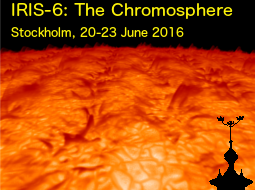Speaker
Rob Rutten
(Lingezicht Astrophysics)
Description
The solar chromosphere observed in H-alpha consists mostly of narrow fibrils. The
longest typically originate in network or plage and arch far over adjacent
internetwork. We use data from SST, IRIS and SDO to analyze one well-observed
example in a quiet area. It resulted from the earlier passage of an accelerating
disturbance in which the gas was heated to transition-region and even coronal
temperatures, as in the spicule-II phenomenon. After this passage a dark fibril
appeared much as contrails appear behind aircraft. We use Saha-Boltzmann extinction
estimation to gauge the onset visibility in various diagnostics and conclude that
such long H-alpha fibrils can indeed be contrail phenomena, not indicative of the
thermodynamic and magnetic environment when they are observed but of more dynamic
preceding happenings. Such H-alpha fibrils do not connect network across
internetwork cells but represent tracks of disturbances launched from either side.
They chart the magnetic field topography at launch, not at present.
Primary author
Rob Rutten
(Lingezicht Astrophysics)

